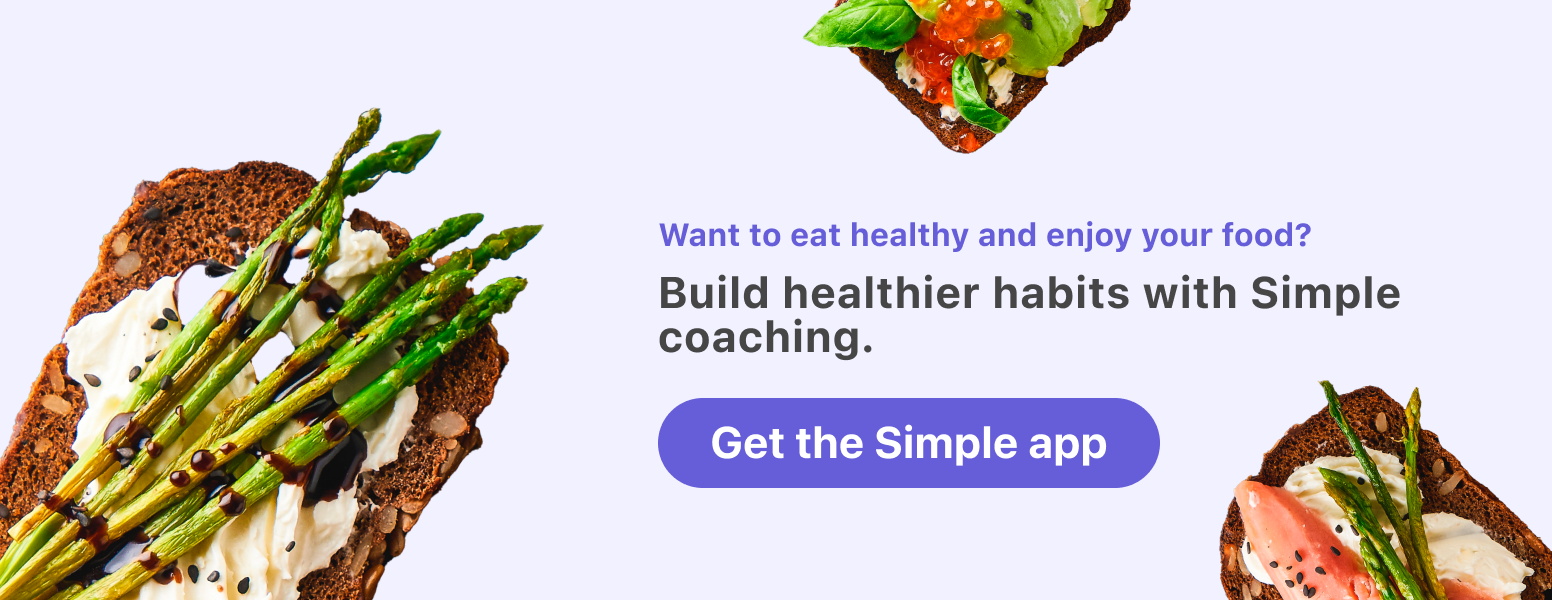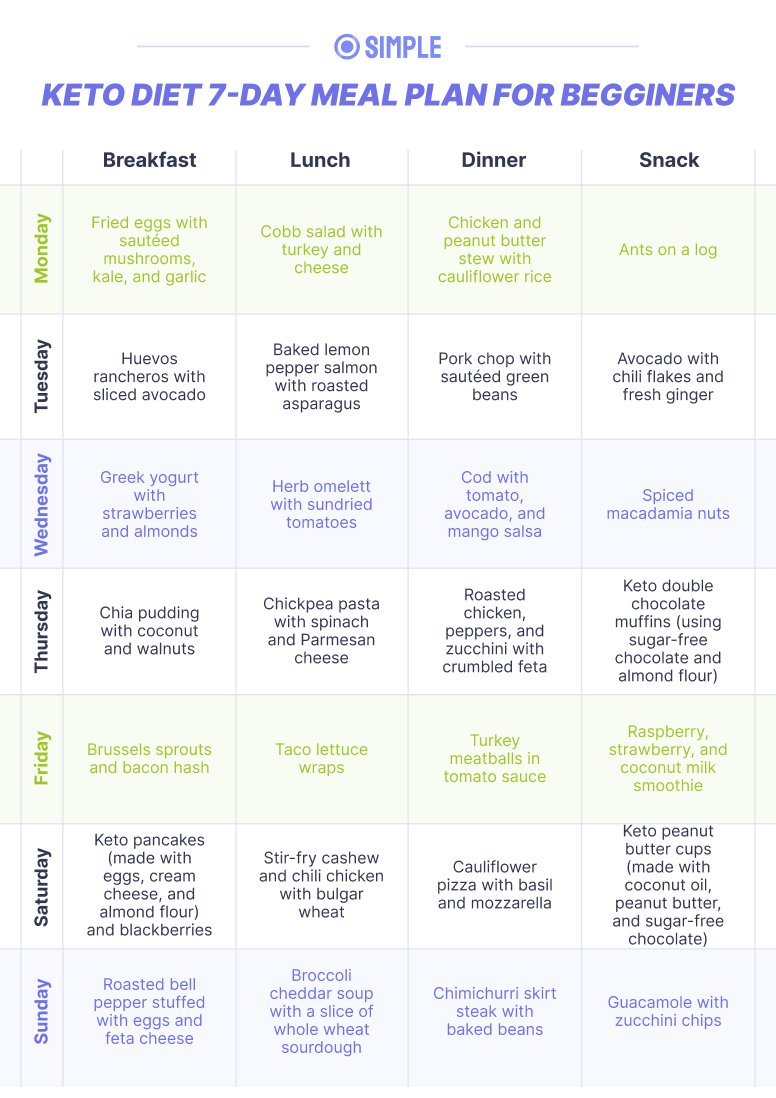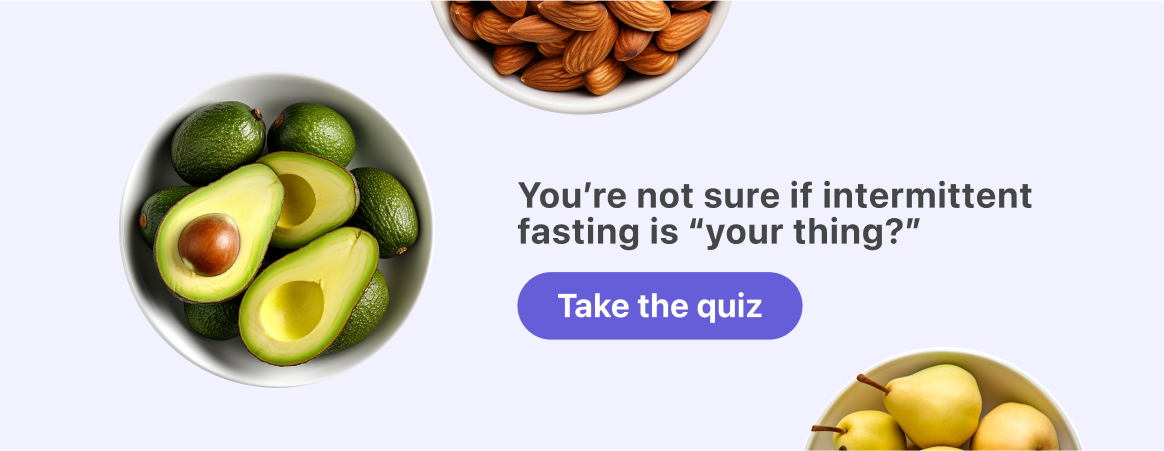Simple’s keto diet meal plan and menu for beginners

When you’re new to an eating routine, figuring out how to meal plan in a way that follows the guidelines of the routine, meets your nutritional needs, supports your health goals, and suits your tastes can feel like navigating a minefield.
So, to help you take those first steps with confidence, we’ve developed a Simple keto meal plan. This free keto diet plan works as a keto diet menu for beginners, but it can also be used by more seasoned keto dieters looking to swap in new recipes to keep things fresh. Heads up, though: remember that keto may not be suitable for everyone, so make sure that you check with your healthcare provider before making any significant lifestyle changes.

Get your knives ready because the keto diet is on the chopping block.
Time to break it down.
The keto diet — what is it?
First, let’s make sure we’re on the same page about what a keto diet actually is before we get into the specifics of keto meal planning.
A ketogenic diet is built around a “high fat, low carb” premise,[1] though it’s more nuanced than “eat more nuts and eat less bread.” A keto diet involves low to moderate carb intake (50–150 g) — including a high intake of fiber from vegetables and whole grains — moderate protein intake, and a high intake of unsaturated (rather than saturated) fats.
Why? The clue is in the name.
A ketogenic diet is intended to make you more likely to achieve ketosis,[2] a natural metabolic state where the body uses fat over sugar as its primary fuel.
How does it work?

When you reduce your carb intake, you subsequently lower the amount of sugar in circulation (fuel from carbs currently being digested) and available glycogen (sugar that has been converted and stored for energy) in your system. With less sugar and glycogen, your body turns to breaking down stored fat instead, which can lead to both fat and weight loss. (Nope, they’re not the same thing! Our fat loss vs. weight loss guide explains.)
A keto diet meal plan isn’t the only way to unlock this fat-burning metabolic state: it can also be triggered by long periods of exercise (where your body is burning through sugar faster) or through certain intermittent fasting schedules (where you take a break from eating for a certain length of time).
Everyone’s body is different, so there’s no way to predict exactly how yours might react to a keto diet or some other form of ketosis-focused meal plan. That’s why you should always work with your healthcare team to ensure your approach is safe, sustainable, and (hopefully!) successful for you.
If you’re considering combining keto and intermittent fasting — which could potentially supercharge your ability to reach ketosis — we’re also ready to be part of your support squad. From general advice on what breaks a fast to guidance on constructing an intermittent fasting meal plan that’s also keto-friendly, we’re pros at sorting through the research and taking the guesswork out of what might work for you. Take our Simple quiz and tell us about your goals to get started.

Keto meal planning types
All keto meal plans have some things in common:
- They’re high in fat (specifically, prioritizing unsaturated fats over saturated fats).
- They’re low in carbs.
- They involve moderate protein intake.
- For safety purposes, they should involve extra hydration (using up stored sugar also involves losing stored water).
Beyond that, keto diet meal plans can come in a variety of forms.
- A beginner keto meal plan may involve a more gradual reduction of carbs and introduction of more fats and protein.
- An easy keto meal plan might focus on a few repeated recipes or easy-to-source ingredients.
- A clean keto meal plan targets foods in their natural, unprocessed state (or as close to that as possible).
- A strict keto meal plan involves staying under 20 grams of carbs per day.
Keto diet meal planning can also vary depending on the specific goals you’re trying to achieve. For example, keto meal planning for muscle gain may involve a greater focus on protein and eating carbs at strategic times before workouts, while keto meal planning for weight loss might involve prioritizing whole foods that are naturally low calorie and nutrient dense.
Benefits and drawbacks of the keto diet
While the general scientific consensus seems to be that more research into the keto diet is needed [3] — especially into the long-term (1+ years) impacts — so far, studies have shown that this eating routine may be beneficial for:
- weight loss (particularly for people with obesity) [4,5]
- brain health and cognition (including for people with neurodegenerative diseases) [6,7,8]
- the reduction of cardiovascular risk factors in people living with overweight or obesity [9]
Beyond the current lack of large-scale, long-term, robust research into the subject and the fact that reaching ketosis can be risky for some people (more on that later), there are a few other potential drawbacks to be aware of.
In the short term, a ketogenic diet can cause:
- the “keto flu” (temporary bouts of headaches, fatigue, dizziness, and cramping) [10]
- bad breath (acetone — one of the main ketones produced during ketosis — may cause a funky, fruity-smelling breath)
Over time, a ketogenic diet can also lead to:
- nutrient deficiencies [11]
- higher cholesterol [12]
- increased risk of heart disease [13]
- decreased kidney health [14]
Simple’s keto diet food list: what to eat and what to avoid
Before we get into our example keto diet meal plan, let’s take a look at what a keto diet menu usually features.
| High-fiber carbs | barley, brown rice, bulgur wheat, oats, quinoa, whole grain bread, whole wheat pasta |
| Unsaturated fats | nuts, seeds, cheese, avocados, nut butters, anchovies, salmon, olives, trout, vegetable and olive oils |
| Lean protein | eggs, chicken, turkey, cottage cheese, Greek yogurt, beans, chickpeas, lentils, tempeh, tofu |
| Non-starchy vegetables | asparagus, broccoli, carrots, peppers, cauliflower, tomatoes, mushrooms, spinach, kale, leafy greens |
| Low-sugar fruits | strawberries, peaches, blackberries, oranges, grapefruits, watermelon |
As with any eating routine, it’s important to strive for a balance that works for you. No food is completely off-limits, especially if that restriction compromises your health or well-being.
That said, here are some foods that are traditionally limited during a keto diet.
| Carb-rich foods (especially those high in refined sugar) | white bread, crackers, noodles, cookies, donuts, candy, cake, ice cream, fries, ketchup, beer, soda, honey, maple syrup |
| Saturated fats (including full-fat dairy products) | butter, cheese, ghee, lard, cream, coconut oil |
| Ultra-processed protein | sausage, pepperoni, hot dogs, deli meats |
| Starchy vegetables | corn, squash, potatoes, sweet potatoes, peas |
| High-sugar fruits | bananas, grapes, pineapple, apples, mangoes |
Simple’s beginner keto diet 7-day meal plan
With the macronutrient management of protein, carbs, and fats involved, it can be tricky to figure out how to navigate a keto diet around different nutritional needs, different schedules, and different personal tastes. Not to mention that no eating routine is a “one size fits all” scenario: much like that misshapen beanie your friend who just took up knitting made for you, your meal plan should fit you comfortably, no grinning and bearing needed.
Our keto diet meal plan keeps it simple by focusing on keto meal examples — and snacks — that are both easy to source and easy to make.
If the options look good to you, brilliant! Run the plan by your doctor or registered dietitian to make sure they’re on board, and if they are, you can use this plan to form your shopping list.
Not a fish person, or maybe you prefer to get protein from legumes? No problem — substitutions and tweaks are absolutely allowed. Take a look at our keto diet food list and try to substitute like for like (er, unsaturated fat for unsaturated fat, for example) to keep the ketogenic balance on track.
If this Simple keto meal plan doesn’t look like something you want to try on for size, that’s totally okay. (We promise we won’t be offended!) It could be a sign that a keto diet may not be right for you or that you have different preferences or dietary requirements that aren’t represented here. Whatever the reason, have a chat with your healthcare team about what you want to achieve with the keto diet, and they’ll be able to make more personalized suggestions.

Click here to download this keto weekly meal plan as a PDF.
Is the keto diet right for you?
Determining whether the keto diet is right for you is a little bit like deciding whether or not you want to tell that friend what you really think of the beanie: ultimately, it depends on what feels best for you (not everyone is comfortable with direct feedback), but your decision could carry unintentional consequences (i.e., receiving a new itchy beanie for every major celebration).
That’s why it’s so important to work with your primary care provider if you’re considering switching up your eating routine or lifestyle. Whether or not something might be effective for the general population doesn’t mean it’s safe and right for you or your goals.
From the more general perspective, as the keto diet can lead to nutrient deficiencies and requires pretty conscious counting of macronutrients, it’s likely not a safe fit for people who:
- have medical conditions that impact the pancreas, liver, thyroid, or gallbladder;
- are prescribed medication;
- are pregnant, breastfeeding, or trying to conceive;
- have a history of or are currently diagnosed with disordered eating;
- are extremely active;
- have a BMI of less than 18.5;
- are under 18 or 80 years old or older.
Additionally, this type of high-fat, low-carb eating routine may be particularly risky for people living with diabetes (especially people with type 1 or type 2 diabetes who are taking certain medications). When ketone levels get too high or are produced too quickly, it can lead to a life-threatening condition called diabetic ketoacidosis.[15]
Likewise, people who already have high cholesterol or other cardiovascular risk factors may need to be extra cautious since some preliminary studies have linked “keto-like” diets to an increased risk of heart disease.[13]

Beginners’ tips for success when meal planning for the keto diet
If your healthcare team gives you the green light, here are our tips for keeping your keto diet introduction as simple and safe as possible.
- Start small. Especially if you’re used to a carb-heavy eating routine, ease into eating more unsaturated fat and lean protein rather than going cold turkey (er, cold pasta?) on the carbs. Give your body time to adjust, and keep checking in with both yourself and your doctor to ensure you’re not putting yourself at risk of nutrient deficiencies (or a major sugar crash!).
- Make time for meal prep. To avoid the temptation of grabbing a few donuts on the way to work or sitting down to a late-night bowl of ice cream, make some meals and snacks ahead of your busiest days so you can have keto-friendly options ready to go.
- Build your meal plan around your schedule — not the other way around. Once you’ve figured out what you want to eat, think about when you want to eat it. If you need more energy in the morning, maybe have more carbs then. If you don’t like a heavy dinner, make lunch your biggest meal. No matter what eating routine you follow, it should be a routine that still allows you to live normally rather than something that dictates the structure of your life.
- Consider water your new best friend. Being in ketosis means you’ll be burning through water faster than ever, so prioritize hydration every step of the way. Bonus: it can also help with hunger pains as you adjust to a new routine (it’s one of our favorite ways to hack hunger while fasting for a reason!). If you get sick of the plain stuff, try infusing it with herbs, spices, or slices of citrus fruit.
- Make meals exciting, but don’t overcomplicate. A new eating routine can open a whole new world of recipe ideas, so don’t be afraid to look far and wide for examples of keto meals that might whet your appetite. On the flip side, you don’t want the idea of trying new things to become an unnecessary hassle — it’s also good to have a few easy and comforting recipes as rotation mainstays, especially if you have a tough week ahead.
Frequently asked questions about a keto diet meal plan
Depending on your existing lifestyle and eating habits, it’s definitely possible that you will lose weight in 10 days on the keto diet. Safe and sustainable weight loss results are gradual, though, so if you’re losing more than a pound or two per week, check in with your doctor.
There isn’t a set number for how many eggs you can eat on the keto diet, but typically, you can eat eggs liberally as they are low in carbs and high in protein and healthy fats. Some people consume up to 3–4 eggs per day, but portion sizes may vary based on individual dietary needs and preferences.
As long as you drink it black, coffee is good for the keto diet — it’s naturally low-carb. If you want to add sweeteners or creamers, stick to keto-friendly ones like monk fruit, stevia, and coconut milk. Heads up, while caffeine in coffee may benefit weight loss,[16] too much of the stuff isn’t great for overall health.[17] (A few cups per day is usually all good!
You can drink alcohol on keto, but for the best results, you want to prioritize no-carb options like rum, vodka, gin, tequila, or whiskey (which you can have straight or with low-calorie mixers like club soda or tonic water). Keep in mind that even if a drink is low-carb, it may still be high in calories, and alcohol can also interfere with fat metabolism and your health over time.[18]
How long you should be on a keto diet depends on your unique needs and goals, and it’s definitely not suitable as a long-term eating routine. On average, people follow the keto diet for a few months, but you should always involve your healthcare team in planning your timeline and approach.

- Masood W, Annamaraju P, Khan Suheb MZ, Uppaluri KR. Ketogenic diet. StatPearls Publishing; 2023.
- Patikorn C, Saidoung P, Pham T, Phisalprapa P, Lee YY, Varady KA, et al. Effects of ketogenic diet on health outcomes: an umbrella review of meta-analyses of randomized clinical trials. BMC Med. 2023 May 25;21(1):196.
- Batch JT, Lamsal SP, Adkins M, Sultan S, Ramirez MN. Advantages and disadvantages of the ketogenic diet: A review article. Cureus. 2020 Aug 10;12(8):e9639.
- Silverii GA, Cosentino C, Santagiuliana F, Rotella F, Benvenuti F, Mannucci E, et al. Effectiveness of low-carbohydrate diets for long-term weight loss in obese individuals: A meta-analysis of randomized controlled trials. Diabetes Obes Metab. 2022 Aug;24(8):1458–68.
- Foster Gary D., Wyatt Holly R., Hill James O., McGuckin Brian G., Brill Carrie, Mohammed B. Selma, et al. A randomized trial of a low-carbohydrate diet for obesity. N Engl J Med. 348(21):2082–90.
- Gough SM, Casella A, Ortega KJ, Hackam AS. Neuroprotection by the ketogenic diet: Evidence and controversies. Front Nutr. 2021 Nov 23;8:782657.
- López-Ojeda W, Hurley RA. Ketone bodies and brain metabolism: New insights and perspectives for neurological diseases. J Neuropsychiatry Clin Neurosci. 2023 Spring;35(2):104–9.
- Jensen NJ, Wodschow HZ, Nilsson M, Rungby J. Effects of ketone bodies on brain metabolism and function in neurodegenerative diseases. Int J Mol Sci. 2020 Nov 20;21(22).
- Dyńka D, Kowalcze K, Charuta A, Paziewska A. The ketogenic diet and cardiovascular diseases. Nutrients. 2023 Jul 28;15(15).
- Bostock ECS, Kirkby KC, Taylor BV, Hawrelak JA. Consumer reports of “keto flu” associated with the ketogenic diet. Front Nutr. 2020 Mar 13;7:20.
- Crosby L, Davis B, Joshi S, Jardine M, Paul J, Neola M, et al. Ketogenic diets and chronic disease: Weighing the benefits against the risks. Front Nutr. 2021 Jul 16;8:702802.
- Burén J, Ericsson M, Damasceno NRT, Sjödin A. A ketogenic low-carbohydrate high-fat diet increases LDL cholesterol in healthy, young, normal-weight women: A randomized controlled feeding trial. Nutrients. 2021 Mar 2;13(3).
- Low-carbohydrate high-fat “keto-like” diet associated with increased risk of CVD [Internet]. American College of Cardiology. [cited 2024 Apr 24]. Available from: https://www.acc.org/Latest-in-Cardiology/Articles/2023/03/01/22/45/Sun-1215pm-kctogenic-acc-2023
- Haring B, Selvin E, Liang M, Coresh J, Grams ME, Petruski-Ivleva N, et al. Dietary protein sources and risk for incident chronic kidney disease: Results from the Atherosclerosis Risk in Communities (ARIC) study. J Ren Nutr. 2017 Jul;27(4):233–42.
- CDC. Diabetic Ketoacidosis [Internet]. Centers for Disease Control and Prevention. 2023 [cited 2024 Apr 24]. Available from: https://www.cdc.gov/diabetes/basics/diabetic-ketoacidosis.html
- Tabrizi R, Saneei P, Lankarani KB, Akbari M, Kolahdooz F, Esmaillzadeh A, et al. The effects of caffeine intake on weight loss: a systematic review and dos-response meta-analysis of randomized controlled trials. Crit Rev Food Sci Nutr. 2019;59(16):2688–96.
- Wikoff D, Welsh BT, Henderson R, Brorby GP, Britt J, Myers E, et al. Systematic review of the potential adverse effects of caffeine consumption in healthy adults, pregnant women, adolescents, and children. Food Chem Toxicol. 2017 Nov;109(Pt 1):585–648.
- Steiner JL, Lang CH. Alcohol, adipose tissue and lipid dysregulation. Biomolecules. 2017 Feb 16;7(1).
